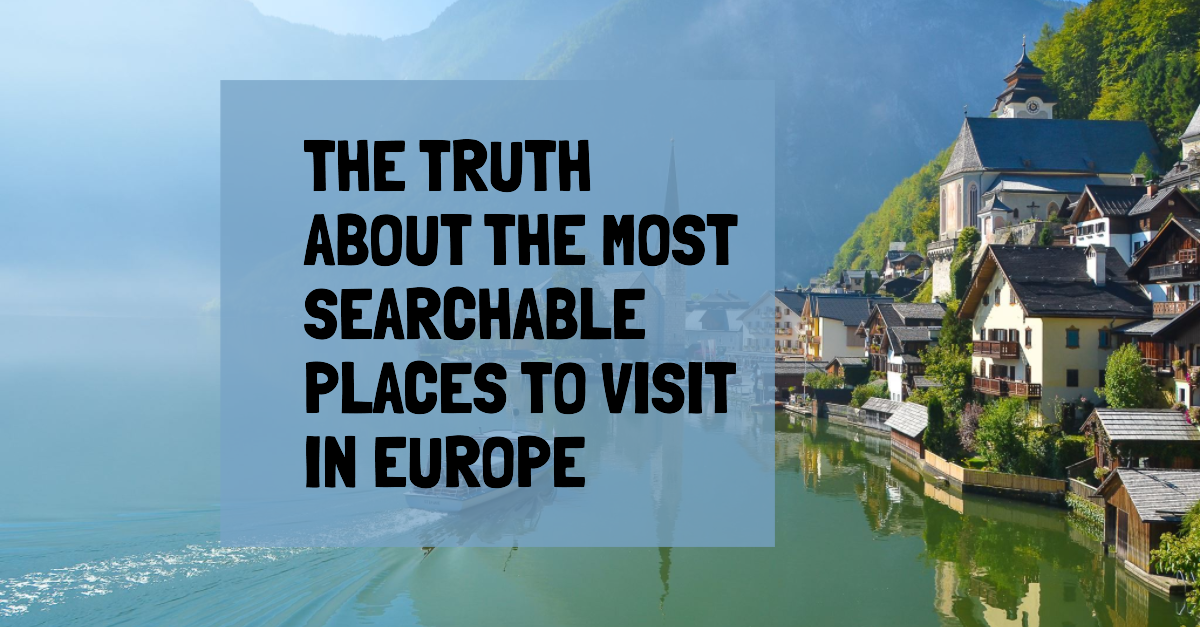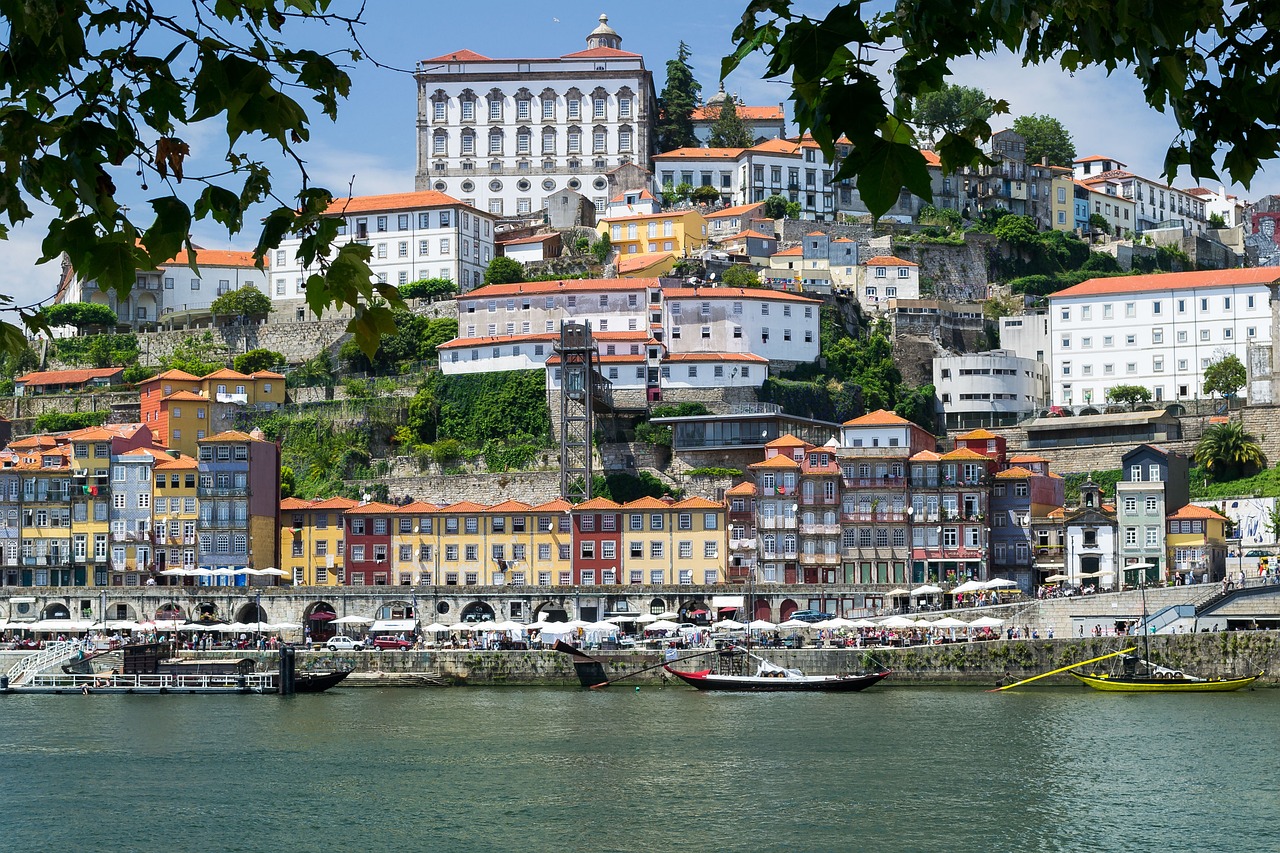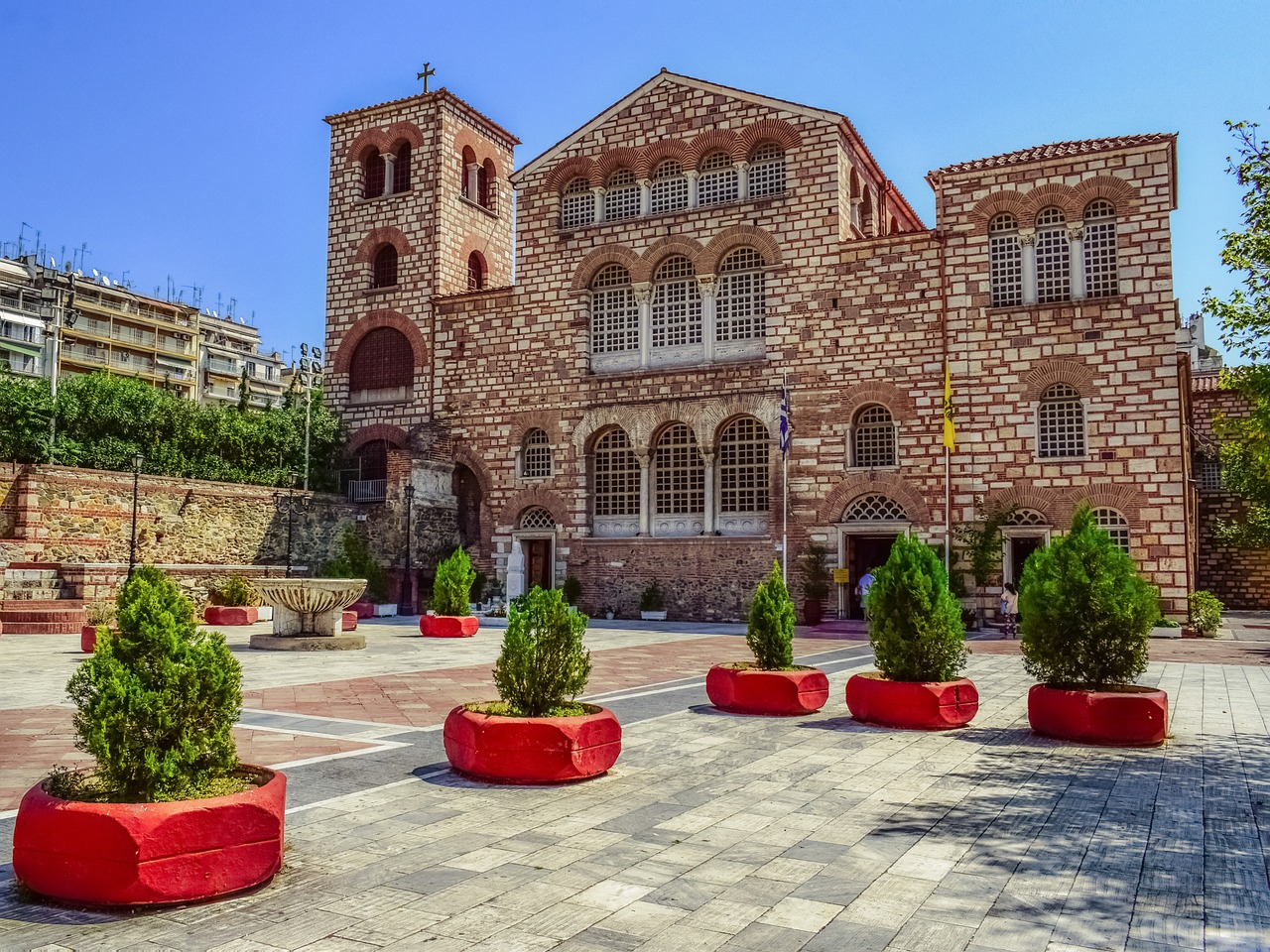If you’re planning a trip to Europe, you’ve probably done your research. You’ve read all the travel blogs, and you’ve made a list of all the must-see attractions. But are you sure you’re not just visiting the most searchable places?
Sure, the Eiffel Tower is iconic, and the Colosseum is historic. But are they really worth the crowds and the overpriced souvenirs?
Here’s a look at some of the most searchable places in Europe, and why you might want to reconsider visiting them:
- The Eiffel Tower: This iconic landmark is one of the most visited tourist attractions in the world. But with over 7 million visitors each year, it can be crowded and chaotic. And if you’re not careful, you could end up spending more time waiting in line than actually enjoying the view.

Eiffel Tower in Paris, France
- The Colosseum: This ancient amphitheater is another must-see for many travelers. But it can be difficult to get a good view of the action, and the crowds can be overwhelming.

Colosseum in Rome, Italy
- The Louvre Museum: This world-famous museum is home to some of the most famous works of art in the world. But it can be overwhelming to try to see everything in one day. And the crowds can be so thick that it’s hard to even move.

Louvre Museum in Paris, France
- The Trevi Fountain: This iconic fountain is a popular spot for tourists to toss coins into. But it can be difficult to get a good picture without being surrounded by other people.

Trevi Fountain in Rome, Italy
- The Leaning Tower of Pisa: This famous tower is definitely worth seeing, but it’s not worth the long wait in line. And if you’re not careful, you could end up getting a ticket for taking a selfie at the base of the tower.

Leaning Tower of Pisa in Pisa, Italy
So, are these places really worth visiting? That’s up to you to decide. But if you’re looking for a more unique and authentic travel experience, you might want to consider visiting some of the lesser-known attractions in Europe.
Here are a few suggestions:
1. The Plitvice Lakes National Park is a breathtaking natural wonder located in Croatia, known for its stunning landscapes, cascading waterfalls, and vibrant turquoise lakes. Here are some interesting things travelers should know about this remarkable destination:
- Natural Beauty: Plitvice Lakes is renowned for its exceptional natural beauty. The park is home to 16 interconnected lakes that are arranged in cascades and connected by a series of waterfalls. The unique geological and hydrological features of the area have led to the formation of these lakes over thousands of years.
- Turquoise Waters: The lakes are characterized by their vivid turquoise and emerald hues, which are a result of the unique composition of minerals and microorganisms present in the water. The colors change with the angle of the sunlight and the minerals in the water, creating a mesmerizing visual experience.
- Waterfalls: The park boasts numerous waterfalls, with the most famous being the Veliki Slap (Great Waterfall), which is the largest waterfall in Croatia. The waterfalls vary in size and intensity, providing a captivating sight and a soothing soundtrack as water flows through the park’s lush landscape.
- Walking Trails: Plitvice Lakes National Park offers a network of well-maintained walking trails that allow visitors to explore the park’s beauty up close. The trails wind around the lakes, across wooden walkways, and through dense forests. The paths are designed to provide different vantage points of the lakes and waterfalls.
- Flora and Fauna: The park is home to diverse flora and fauna, including various species of plants, animals, and birds. It’s a haven for nature enthusiasts and photographers, offering opportunities to spot rare and endemic species in their natural habitats.
- UNESCO World Heritage Site: Plitvice Lakes National Park is a designated UNESCO World Heritage Site, recognized for its exceptional natural value and ecological significance. The park’s unique geological formations and ecosystems make it a globally important destination for conservation.
- Visitor Facilities: The park offers a range of visitor facilities, including information centers, cafes, and souvenir shops. Additionally, there are guided tours available for those who want to learn more about the park’s history, geology, and ecology.
- Seasonal Changes: Plitvice Lakes National Park is captivating year-round. The landscape transforms with the changing seasons, offering different experiences. In the spring and summer, the lush greenery is complemented by blooming flowers, while autumn brings a stunning array of fall colors. Winter transforms the park into a serene snowy wonderland.
- Boat Rides: Visitors can take boat rides across some of the lakes, offering a unique perspective of the park’s waterfalls and scenery. These boat rides provide an opportunity to see the park from a different angle and to appreciate the beauty from the water.
- Conservation Efforts: The park places a strong emphasis on conservation and sustainable tourism. There are regulations in place to protect the delicate ecosystems, so visitors are encouraged to follow the designated paths and respect the natural environment.
Overall, Plitvice Lakes National Park in Croatia offers travelers a truly magical experience with its captivating landscapes, vibrant colors, and tranquil ambiance. It’s a place where nature’s beauty takes center stage and leaves a lasting impression on all who visit.

Plitvice Lakes National Park in Croatia
2. The Amalfi Coast, situated along the southern edge of the Sorrentine Peninsula in Italy, is a world-renowned destination celebrated for its dramatic coastline, picturesque villages, and Mediterranean charm. Here are some fascinating insights for travelers planning to explore the beauty of the Amalfi Coast:
- Breathtaking Scenery: The Amalfi Coast is celebrated for its unparalleled natural beauty. The coastline is characterized by sheer cliffs that plunge into the azure waters of the Tyrrhenian Sea, creating a breathtaking panorama that has inspired artists, writers, and travelers for centuries.
- Charming Coastal Villages: The coast is dotted with enchanting villages that seem to cling to the cliffs overlooking the sea. Amalfi, Positano, Ravello, and Sorrento are among the most famous and picturesque villages in the region. Each village has its own unique character, architecture, and local culture.
- Positano’s Vertical Beauty: Positano is perhaps the most iconic village on the coast, known for its pastel-colored buildings cascading down the cliffs in a vertical fashion. Narrow streets, boutique shops, and charming cafés contribute to the village’s romantic atmosphere.
- Amalfi’s Maritime Heritage: The town of Amalfi was once a powerful maritime republic and played a significant role in Mediterranean trade. Visitors can explore historical sites like the Cathedral of St. Andrew and the Arsenal of the Maritime Republic, reflecting the town’s rich history.
- Ravello’s Cultural Haven: Ravello is renowned for its cultural heritage and stunning villas. The Villa Cimbrone and Villa Rufolo offer stunning gardens, panoramic views, and a setting that has attracted artists and intellectuals for generations.
- Scenic Drives and Hikes: The Amalfi Coast Drive, often referred to as the “Strada Statale 163,” is a winding coastal road that offers some of the most breathtaking views in the world. Hiking trails like the Path of the Gods (Sentiero degli Dei) provide an opportunity to explore the coastline on foot and enjoy spectacular vistas.
- Local Cuisine: The region’s culinary offerings are a highlight for food enthusiasts. Taste fresh seafood, homemade pasta dishes, and locally grown produce. Lemons are a staple of Amalfi Coast cuisine, and you can enjoy dishes like “Linguine al Limone” (pasta with lemon) and the famous “Limoncello” liqueur.
- Cultural Events: Throughout the year, the Amalfi Coast hosts various cultural events, festivals, and concerts. The Ravello Festival is particularly renowned, featuring a series of classical music performances against the backdrop of Ravello’s stunning scenery.
- Beaches and Clear Waters: Despite the rocky coastline, the Amalfi Coast boasts some beautiful beaches and coves. Many villages have small beach areas where you can relax and swim in the clear waters of the Mediterranean.
- Artisanal Crafts: The region is known for its traditional craftsmanship. You can find handmade ceramics, intricate lacework, and other locally produced crafts in the villages’ boutiques and markets.
- Island Escapes: While not part of the Amalfi Coast per se, nearby islands like Capri and Ischia offer additional opportunities for exploration, relaxation, and scenic beauty.
The Amalfi Coast’s blend of natural splendor, charming villages, and rich history creates an unforgettable travel experience. Whether you’re drawn by the stunning coastal views, the local cuisine, or the cultural gems scattered along the shoreline, the Amalfi Coast is sure to captivate your senses and leave you with lasting memories.

Amalfi Coast in Italy
3. The Dolomites, a stunning mountain range located in northeastern Italy, are a paradise for nature lovers, outdoor enthusiasts, and those seeking breathtaking alpine landscapes. Here are some captivating details for travelers looking to explore the beauty and wonders of the Dolomites:
- Unique Geological Formation: The Dolomites are renowned for their distinctive geological composition. The rock formations are composed of dolomite, a type of mineral that gives the mountains their unique pinkish hue. This creates a captivating contrast against the blue sky, especially during sunrise and sunset.
- UNESCO World Heritage Site: In 2009, the Dolomites were designated as a UNESCO World Heritage Site for their outstanding natural beauty, unique geology, and cultural significance. The region encompasses nine different mountain ranges and several nature parks.
- Outdoor Adventures: The Dolomites offer a plethora of outdoor activities year-round. From hiking and mountain biking in the summer to skiing, snowboarding, and snowshoeing in the winter, the region caters to all levels of adventure seekers.
- Skiing and Winter Sports: The Dolomites are a renowned winter sports destination with numerous ski resorts. The area is part of the Dolomiti Superski, one of the largest ski networks in the world, offering access to a vast range of slopes, trails, and facilities.
- Via Ferrata Routes: For those seeking a mix of adventure and stunning vistas, the Dolomites are known for their extensive network of via ferrata routes. These protected climbing paths equipped with cables, ladders, and fixed anchors allow both experienced climbers and beginners to access panoramic viewpoints.
- Alpine Lakes and Meadows: The Dolomites are dotted with pristine alpine lakes, surrounded by lush meadows and forests. Lago di Braies, Lago di Sorapis, and Lago di Carezza are just a few of the stunning lakes that offer serene settings for relaxation and exploration.
- Cultural Richness: The Dolomites are not only about natural beauty but also about the local culture. The region is home to traditional Tyrolean villages, each with its own architecture, customs, and cuisine. Experience the warm hospitality of the locals and savor traditional Alpine dishes.
- The Tre Cime di Lavaredo: These iconic three peaks are among the most recognizable landmarks in the Dolomites. They offer spectacular views and are a popular hiking destination, providing a range of trails for various levels of fitness.
- Alpenglow: One of the most magical moments in the Dolomites is experiencing the alpenglow. As the sun sets, the mountains often light up in shades of pink and orange, creating a surreal and enchanting atmosphere.
- Photographer’s Paradise: Whether you’re an amateur or professional photographer, the Dolomites provide endless opportunities for capturing stunning landscapes, dramatic lighting, and vibrant colors.
- Local Cuisine: Enjoy the hearty and delicious Alpine cuisine. Treat yourself to dishes like “speck” (cured ham), “knödel” (dumplings), and flavorful cheeses. Don’t forget to pair your meal with a glass of local wine.
From its jagged peaks to its lush valleys, the Dolomites offer a diverse range of experiences that cater to different interests and seasons. Whether you’re seeking adrenaline-pumping adventures, serene natural beauty, or a blend of both, the Dolomites will undoubtedly leave you in awe of its magnificence.

Dolomites in Italy
4. The Azores, an archipelago located in the North Atlantic Ocean, is a hidden gem of natural beauty and tranquility. As an autonomous region of Portugal, the Azores offer travelers a unique blend of stunning landscapes, diverse ecosystems, and a rich cultural heritage. Here are some intriguing insights for travelers looking to explore the wonders of the Azores:
- Volcanic Landscapes: The Azores are known for their dramatic volcanic landscapes, characterized by lush green hills, volcanic craters, calderas, and lava formations. The islands themselves were formed by volcanic activity, creating a striking and unique environment.
- São Miguel’s Hot Springs and Geothermal Pools: São Miguel, the largest island, boasts impressive geothermal activity. The Furnas Valley is famous for its hot springs, geysers, and thermal baths, offering visitors a chance to relax in naturally heated waters.
- Stunning Lakes: The Azores are home to several beautiful crater lakes with vibrant blue and green hues. Lagoa das Sete Cidades on São Miguel is particularly famous for its twin lakes—one blue and one green—set against a breathtaking backdrop.
- Whale Watching and Marine Life: The Azores are one of the best places in the world for whale watching. The surrounding waters are home to numerous species of whales and dolphins, and there are several tour operators that offer guided boat trips for a chance to see these majestic creatures.
- Rich Biodiversity: The Azores offer a diverse range of ecosystems, from coastal areas to dense forests. The islands are home to unique flora and fauna, including endemic species like the Azores bullfinch and Azores laurel.
- Adventure Activities: The Azores are a haven for outdoor enthusiasts. Activities such as hiking, mountain biking, kayaking, and even paragliding are popular ways to explore the islands’ natural beauty.
- Traditional Cuisine: Experience the local Azorean cuisine, which features fresh seafood, locally raised beef, and dairy products. The cozido das Furnas, a traditional stew cooked underground using geothermal heat, is a must-try dish.
- Historical Sites and Architecture: Explore charming towns with cobbled streets and historic architecture. Ponta Delgada, Angra do Heroísmo, and Horta each have their own distinct character and offer a glimpse into the Azores’ history.
- Whaling Heritage: The Azores have a history of whaling, and you can learn about this cultural aspect at museums and historical sites. The islands have transitioned from whaling to sustainable whale watching practices.
- Unspoiled Nature: The Azores are known for their pristine natural beauty and efforts to preserve their environment. The islands are a paradise for those seeking untouched landscapes and a sense of tranquility.
- UNESCO Biosphere Reserves: The islands of Corvo, Flores, Graciosa, and São Jorge have been designated UNESCO Biosphere Reserves due to their commitment to sustainable development and conservation.
- Festivals and Local Traditions: The Azores have a vibrant cultural scene, with traditional festivals, music, and crafts that reflect the islands’ rich heritage and strong sense of community.
Whether you’re drawn to the islands for their natural wonders, marine life, outdoor activities, or cultural experiences, the Azores offer a unique and memorable travel destination that promises to leave a lasting impression.

Azores in Portugal
5. The Faroe Islands, an autonomous territory within the Kingdom of Denmark, are a remote and captivating destination in the North Atlantic Ocean. Known for their rugged landscapes, unique culture, and vibrant traditions, the Faroe Islands offer travelers an off-the-beaten-path experience that is rich in natural beauty and cultural heritage. Here are some fascinating insights for travelers interested in exploring the Faroe Islands:
- Spectacular Landscapes: The Faroe Islands are renowned for their dramatic and diverse landscapes. The islands are characterized by steep cliffs, deep fjords, lush valleys, and rolling hills. The ever-changing weather adds an ethereal quality to the scenery.
- Vibrant Birdlife: The islands are a paradise for birdwatchers. Puffins, guillemots, fulmars, and other seabirds thrive in the cliffs and coastal areas, making the Faroe Islands a prime destination for bird enthusiasts.
- Traditional Sod Roof Houses: The Faroe Islands are known for their picturesque villages with traditional sod roof houses. These charming, grass-covered roofs not only provide insulation but also add to the unique aesthetic of the islands.
- Outdoor Adventures: The Faroe Islands offer various outdoor activities, including hiking, mountain climbing, kayaking, and fishing. The rugged terrain and stunning vistas make it a playground for those seeking adventure in nature.
- Sheep and Sheep Culture: Sheep farming is a significant part of the Faroese culture and economy. The islands are home to a large number of sheep that roam freely on the grassy hillsides.
- Unspoiled Nature: The islands are relatively untouched by mass tourism, allowing visitors to experience pristine nature, clean air, and an unspoiled environment.
- Faroese Cuisine: The Faroe Islands have a unique culinary scene. Traditional dishes often include locally sourced ingredients such as lamb, seafood, and seabirds. Try specialties like fermented lamb and “skerpikjøt,” dried mutton.
- Weather Variability: The weather in the Faroe Islands can change rapidly, with sunshine, rain, fog, and mist occurring all within a short period. Be prepared for changing conditions and enjoy the atmospheric shifts that come with them.
- Rich Viking Heritage: The Faroe Islands have a strong connection to their Viking past. Historical sites and artifacts, such as old stone structures and burial mounds, offer insights into the islands’ history and heritage.
- Tórshavn: The capital city, Tórshavn, is one of the world’s smallest capitals. Despite its size, it has a charming mix of old and new, with colorful buildings, modern amenities, and cultural attractions.
- Midsummer Festival: The Olavsøka festival, held around July 29th, is one of the most important cultural events in the Faroe Islands. It celebrates the Faroese National Day and includes music, dancing, boat races, and other festivities.
- Isolated Beauty: The Faroe Islands’ remoteness and untouched beauty create an almost mystical atmosphere that appeals to travelers seeking a sense of isolation and a deeper connection with nature.
- Sustainable Tourism: The Faroe Islands are committed to sustainable tourism practices to protect their delicate ecosystems and preserve their unique culture and traditions.
Visiting the Faroe Islands is an opportunity to experience a truly distinctive and enchanting destination where raw natural beauty and a resilient culture come together to create an unforgettable travel experience.

Faroe Islands in Denmark
In conclusion, these are just a few suggestions, of course. There are many other amazing places to visit in Europe. So, do your research, and find the places that are right for you. And don’t be afraid to go off the beaten path. You might just be surprised at what you find.



